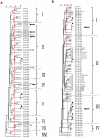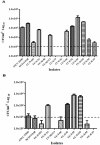Genotypic and phenotypic properties of cattle-associated Campylobacter and their implications to public health in the USA
- PMID: 22046247
- PMCID: PMC3198382
- DOI: 10.1371/journal.pone.0025778
Genotypic and phenotypic properties of cattle-associated Campylobacter and their implications to public health in the USA
Abstract
Since cattle are a major source of food and the cattle industry engages people from farms to processing plants and meat markets, it is conceivable that beef-products contaminated with Campylobacter spp. would pose a significant public health concern. To better understand the epidemiology of cattle-associated Campylobacter spp. in the USA, we characterized the prevalence, genotypic and phenotypic properties of these pathogens. Campylobacter were detected in 181 (19.2%) out of 944 fecal samples. Specifically, 71 C. jejuni, 132 C. coli, and 10 other Campylobacter spp. were identified. The prevalence of Campylobacter varied regionally and was significantly (P<0.05) higher in fecal samples collected from the South (32.8%) as compared to those from the North (14.8%), Midwest (15.83%), and East (12%). Pulsed Field Gel Electrophoresis (PFGE) analysis showed that C. jejuni and C. coli isolates were genotypically diverse and certain genotypes were shared across two or more of the geographic locations. In addition, 13 new C. jejuni and two C. coli sequence types (STs) were detected by Multi Locus Sequence Typing (MLST). C. jejuni associated with clinically human health important sequence type, ST-61 which was not previously reported in the USA, was identified in the present study. Most frequently observed clonal complexes (CC) were CC ST-21, CC ST-42, and CC ST-61, which are also common in humans. Further, the cattle associated C. jejuni strains showed varying invasion and intracellular survival capacity; however, C. coli strains showed a lower invasion and intracellular survival potential compared to C. jejuni strains. Furthermore, many cattle associated Campylobacter isolates showed resistance to several antimicrobials including ciprofloxacin, erythromycin, and gentamicin. Taken together, our results highlight the importance of cattle as a potential reservoir for clinically important Campylobacter.
Conflict of interest statement
Figures




Similar articles
-
Phenotypic and genotypic diversity of thermophilic Campylobacter spp. in commercial turkey flocks: a longitudinal study.Foodborne Pathog Dis. 2014 Nov;11(11):850-60. doi: 10.1089/fpd.2014.1794. Epub 2014 Sep 3. Foodborne Pathog Dis. 2014. PMID: 25184688 Free PMC article.
-
Molecular epidemiology and public health relevance of Campylobacter isolated from dairy cattle and European starlings in Ohio, USA.Foodborne Pathog Dis. 2013 Mar;10(3):229-36. doi: 10.1089/fpd.2012.1293. Epub 2012 Dec 21. Foodborne Pathog Dis. 2013. PMID: 23259503
-
Antimicrobial resistance profiling and molecular subtyping of Campylobacter spp. from processed turkey.BMC Microbiol. 2009 Sep 21;9:203. doi: 10.1186/1471-2180-9-203. BMC Microbiol. 2009. PMID: 19772592 Free PMC article.
-
Prevalence and antimicrobial resistance of Campylobacter jejuni and Campylobacter coli over time in Thailand under a One Health approach: A systematic review and meta-analysis.One Health. 2025 Jan 10;20:100965. doi: 10.1016/j.onehlt.2025.100965. eCollection 2025 Jun. One Health. 2025. PMID: 39898318 Free PMC article. Review.
-
The Prevalence of Campylobacter in Live Cattle, Turkey, Chicken, and Swine in the United States and Canada: A Systematic Review and Meta-Analysis.Foodborne Pathog Dis. 2021 Apr;18(4):230-242. doi: 10.1089/fpd.2020.2834. Epub 2020 Dec 7. Foodborne Pathog Dis. 2021. PMID: 33290141
Cited by
-
Risk factors for campylobacteriosis in two washington state counties with high numbers of dairy farms.J Clin Microbiol. 2013 Dec;51(12):3921-7. doi: 10.1128/JCM.01433-13. Epub 2013 Sep 11. J Clin Microbiol. 2013. PMID: 24025908 Free PMC article.
-
Prevalence, Risk Factors, and Antimicrobial Resistance Profiles of Thermophilic Campylobacter Species in Humans and Animals in Sub-Saharan Africa: A Systematic Review.Int J Microbiol. 2020 Jan 14;2020:2092478. doi: 10.1155/2020/2092478. eCollection 2020. Int J Microbiol. 2020. PMID: 32025233 Free PMC article. Review.
-
Phenotypic and genotypic diversity of thermophilic Campylobacter spp. in commercial turkey flocks: a longitudinal study.Foodborne Pathog Dis. 2014 Nov;11(11):850-60. doi: 10.1089/fpd.2014.1794. Epub 2014 Sep 3. Foodborne Pathog Dis. 2014. PMID: 25184688 Free PMC article.
-
Insufficient Discriminatory Power of Matrix-Assisted Laser Desorption Ionization Time-of-Flight Mass Spectrometry Dendrograms to Determine the Clonality of Multi-Drug-Resistant Acinetobacter baumannii Isolates from an Intensive Care Unit.Biomed Res Int. 2015;2015:535027. doi: 10.1155/2015/535027. Epub 2015 May 25. Biomed Res Int. 2015. PMID: 26101775 Free PMC article.
-
Effect of Danofloxacin Treatment on the Development of Fluoroquinolone Resistance in Campylobacter jejuni in Calves.Antibiotics (Basel). 2022 Apr 15;11(4):531. doi: 10.3390/antibiotics11040531. Antibiotics (Basel). 2022. PMID: 35453282 Free PMC article.
References
-
- Allos BM. Campylobacter jejuni infections: update on emerging issues and trends. Clin Infect Dis. 2001;32:1201–1206. - PubMed
-
- Miller WG, Mandrell RE. Prevalence of Campylobacter in the food and water supply: incidence, outbreaks, isolation and detection. In: Ketley JM, Konkel ME, editors. Campylobacter: Molecular and Cell Biology. Norfolk, UK: Horizon Biosciences; 2005. pp. 101–63.
-
- Piddock IJN, Ricci V, Stanley K, Jones K. Activity of antibiotics used in human and medicine for Campylobacter jejuni isolated from farm animals and their environment in Lancashire, UK. J Antimicrob Chemother. 2000;46:303–306. - PubMed
Publication types
MeSH terms
LinkOut - more resources
Full Text Sources
Medical
Miscellaneous

